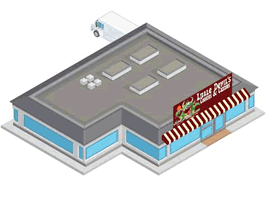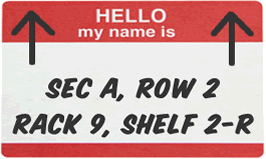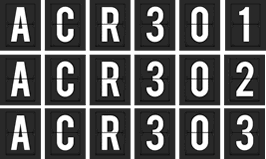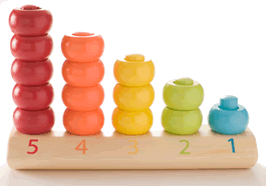Inventory Basics
Overview
This is a detailed guide to getting started. We make the assumption that you’re starting from scratch, with only a vague system for tracking your inventory. You may not have part numbers, named locations, or the most basic attributes of a simple inventory system. (You may not have any inventory system in place at all!) Even if you never use our software, we hope that you’ll find this guide to inventory basics helpful for setting up a system that gets the job done.

Quick Summary
Get right to the point below, or scroll down for a thorough explanation. The following are the key elements to a well organized inventory tracking system.
- Create well designed location names and clearly label all locations where items may be stored.
- Use well organized, consistent, and unique descriptions of your items, starting with nouns.
- Keep item identifiers (part numbers, sku’s, etc..) short, consistently formatted, unique, and avoid common pitfalls.
- Decide if you will need to use units of measure, and if so, make sure they are formatted consistently and used properly.
- Make sure you have a good starting count of all your items, their locations, and any other relevant inventory data
- Use an inventory tracking software like Clearly Inventory. Spreadsheets or written lists do not work well in the long term.
- Create solid inventory management policies and train your people to follow them.
Detailed Explanation of Inventory Basics
Welcome to “Sweet Little Devils Cookies and Candies”. In this basic inventory guide, we will use this small, fictional business to explore the process of setting up an inventory system. This process works in the physical world, and in our software. Here’s a recent aerial photo of the business:

Sweet Little Devils makes and sells cookies, candies, coffee drinks, and other cafe items. Some items are made from scratch, while others are bought and sold. They also ship direct to customers, who order products from their web site, www.sweetlittledevils.com. Unbeknownst to them, their actions are used in this basic inventory guide to show the world how to set up an effective inventory system.
Let’s follow along
The Elements of a Pretty Good Inventory System
We like our Clearly Inventory software. We think it’s easy to use, and we know that it will help you become more productive. But no matter how good we think it is, it will fail to help you if you don’t do some very basic things.
The purpose of this section of the Getting Started Guide is to walk you through the absolute basic attributes of a pretty good inventory management system. And to instruct you in detail about how to implement our recommendations.
We say “Pretty Good” because there are no perfect ways to create the above elements, but there are lots of bad ways. You may be able to improve on our recommendations or your enterprise may have to do things differently but if you follow our recommendations you’ll wind up with a pretty good system.
The Critical Elements of a Pretty Good Inventory System
- Well Organized Location Names
- Location Labels that are easy to read, and unambiguous
- Unique, Short, and Unmistakable Item Numbers
- Units of Measure
- A Good Starting Count
- Software that tracks all inventory activity
- Good Policies
- Most Important: People who know and follow good policies
Before we get into each of the above elements in more detail, let’s take a moment to explain why these elements are so important.
Well Organized Location Names & Location Labels that are easy to read, and unambiguous
If an item can be stored somewhere, that ‘somewhere’ must have a name, and it should be labeled with that name. If it doesn’t, time will be wasted looking for things. People will stock things in the wrong place. Locations will get referred to by more than one name, and your inventory will be in constant drift towards disorganization.
Remember, any open space can potentially store stuff, so label ALL of your storage locations, not just the ones that currently have stock. An open aisle? Name it, label it. An empty corner? Name it, label it. The tiny water heater closet? Name it, label it.
And don’t pick just any name. You must have some logic to your location naming scheme. If you don’t, you’re setting yourself up for frustration in ways that are difficult to anticipate. We’ll give you some advice on a naming scheme later in this guide to inventory basics. No matter what you decide to call your locations, make sure they’re all labeled, and all the names are unique.
Labels that are easy to read help everyone work faster. For example, if the letters on your labels are so small that you have to be two feet away to read them, or if the labels blend in with rack colors, etc… You’ll be slowing down your operations and opening up yourself to mistakes.
Labels that don’t clearly state which location they’re referring to (i.e. shelf labels, with no arrows, and shelves above and below) will cause the same delays and errors as poorly printed labels.

Sign Up and Upload Your Inventory Spreadsheets
We’ll configure your inventory, organize your data, and upload it in just a few hours.
All for Free for a Limited Time Only (No Credit Card Required)
Item Descriptions
All of your items should have well-defined, unique descriptions, for many of the same reasons that apply to locations. Without good descriptions, people may be confused about whether they have stock on an item, or what items needs to be ordered. It can also be hard to search for items in reports, or find similar items in your inventory system. Our opinions about creating good descriptions for your items are thorough and we’ll explain in greater detail later.

Item Numbers, Product Codes, UPC Codes, SKU Numbers, Etc…
Item numbers help uniquely identify items, but one of their greatest benefits is lost on people who haven’t used a software system to track their inventory: they serve as a shorthand, or abbreviated item description. When you are searching your inventory, making transactions, filling orders, filtering or searching reports, item numbers really come in handy. Instead of typing descriptions that can be hundreds of characters long, and hard to distinguish at a glance, most companies can use items numbers of only five or six characters or numbers in length. It makes it easier to use your inventory software, and anything that makes something easier, improves the chances that it will get done. For more tips, refer to our other guides in the Inventory Basics section under Resources.

Units of Measure
Units of Measure, things like “pcs” “ea” “lbs” “bags” etc… give meaning to quantities. These units belong in their own separate place, outside of descriptions and the numeric quantity fields. Using well created and consistent units of measure will make stock levels, shipping quantities, and ordering quantities, easier to understand.

A Good Starting Count
Loading data into a new inventory software program is an excellent time to get a good count of your stock levels. Once you have labeled your locations, cleaned up your descriptions, created item numbers, and consistent units of measure, getting a good stock level count will be easier, faster, and better organized.

A Software System that Tracks all Inventory Activity
If you’re reading this guide to inventory basics, you probably realize that keeping your inventory data with pen and paper, or on a spreadsheet, just won’t cut it. Good inventory software will make it easier for you to to track your inventory and allow many users access to it. It also provides insight to your inventory activity, and helps keep an accurate historical record of what’s happened.
Creating Policies and Training People about the Entire Inventory System
The people who work with your stock and use your inventory system are the most critical element in establishing a pretty good inventory management system. You must make sure that these people know what to do with items that are received, removed, reserved for future use, required for production. They also must know who is responsible for making certain transactions, etc… In some cases this may only be one or two people, but there’s nothing wrong with writing down your policies and making sure they are followed. You may want to share this guide to inventory basics with them to reinforce the point. If you or the people you work with aren’t consistent in the way inventory is handled, it won’t matter what software you use, you will only experience frustration and failure.
